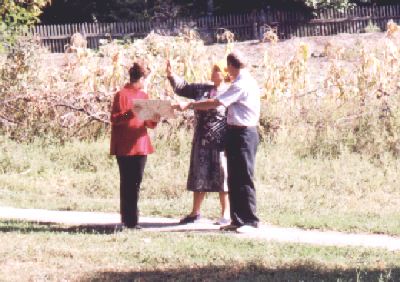| Borosenko was a daughter colony of Molotschna. In 1865, the Mennonite colonies
had the opportunity to purchase the estate of a Russian nobleman, Borso. A few years
earlier, in 1861, the serfs had been freed, and it was often difficult to keep up large
estates without the services of these virtual slaves. The Kleine Gemeinde church bought
16,500 acres for 120 of their families to move, including those of 3G-grandfather Isaak
Harms, two sons and a daughter. The land is not nearly so rich as that of
Molotschna, but it allowed people in the congregation to stay together and provided land
for those who had none.
 Getting to the
location of the former Borosenko is no mean task. We drove southwest to Nikopol, and
then our driver, Boris, and our guide, Vicka, repeatedly had to get directions. Getting to the
location of the former Borosenko is no mean task. We drove southwest to Nikopol, and
then our driver, Boris, and our guide, Vicka, repeatedly had to get directions.
Some of the guides contend that there are few if any accurate maps in Ukraine. The
former Soviet government included map-making in their various programs of disinformation.
In any case, drivers (even men!) never trusted maps alone.
Once we got sorted out in Nikopol, we were on our way -- except for one incident.
A routine police stop resulted in the driver going behind the van for an
inspection, and rather than be troubled with a ticket, he "settled up" on the
spot. |